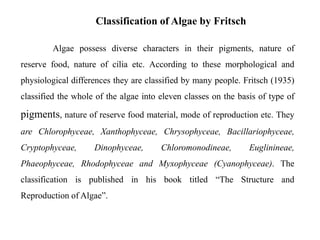
algae classification.pptx
- 1. Algae possess diverse characters in their pigments, nature of reserve food, nature of cilia etc. According to these morphological and physiological differences they are classified by many people. Fritsch (1935) classified the whole of the algae into eleven classes on the basis of type of pigments, nature of reserve food material, mode of reproduction etc. They are Chlorophyceae, Xanthophyceae, Chrysophyceae, Bacillariophyceae, Cryptophyceae, Dinophyceae, Chloromonodineae, Euglinineae, Phaeophyceae, Rhodophyceae and Myxophyceae (Cyanophyceae). The classification is published in his book titled “The Structure and Reproduction of Algae”. Classification of Algae by Fritsch
- 2. 1. Class: Chlorophyceae (Green Algae) Occurrence: Most forms are fresh water and a few are marine. Pigments: Chief pigments are chlorophyll a an b and carotenoids (yellow pigments) Reserve food: Starch Structure: Unicellular motile to heterotrichous filaments. Cell wall consists of Cellulose. Pyrenoids are commonly surrounded by starch sheath. Motile cells have equal flagella. Reproduction: Sexual reproduction ranges from isogamous to advanced oogamous type. Example: Chlamydomonas, Volvox, Chlorella, Scenedesmus ,Pediastrum
- 3. 1. Desmotetra 2. Stigeoclonium 3. Desmodesmus 4. Chlamydomonas 5. Pediastrum 6. Volvox
- 4. 2. Class: Xanthophyceae (Yellow green algae) Occurrence: Most forms are fresh water but a few are marine. Pigments: Yellow xanthophyll is found abundantly. Reserve food: oil Structure: Unicellular motile to simple filamentous. Cell wall rich in pectic compounds and composed of two equal pieces overlapping at their edges. Motile cells have two very unequal flagella. Pyrenoids absent. Reproduction: Sexual reproduction is rare and always isogamous. Example: Vaucheria
- 6. 3. Class: Chrysophyceae Occurrence: Most forms occur in cold fresh water but a few are marine. Pigments: Chromatophores are brown or orange colored. Phycochrysin serves as chief accessory pigments. Reserve food: Fat and leucosin. Structure: Plants are unicellular motile to branched filamentous. Flagella are unequal attached at front end. Cells commonly contain one or two parietal chrmoatophores. Reproduction: Sexual reproduction seldom occurs but is of isogamous type.
- 7. 4. Class: Bacillariophyceae (Diatoms) Occurrence: In all kind of fresh water, sea, soil and terrestrial habitats. Pigments: Chromatophores are yellow or golden brown. Nature of accessory pigments is not very definite. Reserve food: Fat and volutin. Structure: All the members are unicellular or colonial. Cell wall is partly composed of silica and partly of pectic substances. It consists of two halves and each has two or more pieces. Cell wall is richly ornamental Reproduction: Forms are diploid. Sexual reproduction is special type, occurs by fusion of protoplasts of the ordinary individuals.
- 8. Diatoms
- 9. 5. Class: Cryptophyceae Occurrence: Both in marine and fresh water Pigments: Chromatophores show diverse pigmentation. It may be some shades of brown. Chromatophores are usually parietal. Reserve food: Solid carbohydrates or in some cases starch. Structure: Represented by motile cells and most advanced forms are coccoid, flagella are slightly unequal. Reproduction: Isogamous in the reported cases. Example: Chroomonas
- 10. 6. Class: Dinophyceae Occurrence: Plants occur widely as sea water planktons. A few may be fresh water forms. Pigments: Starch and oil Reserve food: Chromaophores are dark yellow, brown , etc., and contain a number of special pigments. Structure: plants are unicellular motile to branched filamentous. Reproduction: Sexual reproduction is of isogamous type. it is rare and not very definite. Example: Dinoflagellate , Ceratium
- 12. 7. Class: Chloromonadineae Occurrence: All plants are fresh water forms. Pigments: Chromatophores are bright green in colour and contain an excess of xanthophyll. Reserve food: Oil Structure: The plants are motile, flagellate with two almost equal flagella.
- 13. 8. Class: Euglenineae Occurrence: Only fresh water forms are known. Pigments: Chromatophores are pure green. Each cell has several chromatophores. Reserve food: Polysaccharide and Paramylon Structure: Motile flagellates, flagella may be one or two arising from the base of canal like invagination at the front end. Complex vacuolar system and a large and prominent nucleus. Reproduction: Sexual reproduction is not substantially known. It is isogamous type. Example: Euglena
- 14. 9. Class: Phaeophyceae (Brown algae) Occurrence: Mostly marine Pigments: chl a, c, carotenes, xanthophylls, not chl b Reserve food: Mannitol as well as laminarin and fats Structure: The plants may be simple filamentous to bulky parenchymatous forms. Several plants attain giant size, external and internal differentiation. Reproduction: Sexual reproduction ranges isogamous to oogamous. Motile gametes have two laterally attached flagella. Varied types of alternation of generation. Example: Ectocarpus, Sargassum
- 16. 10. Class: Rhodophyceae (Red algae) Occurrence: Few forms are fresh water and others are marine. Pigments: Chromatophores are res blue containing pigments like red phycoerythrin and blue phycocyanin, Chl-a,d, carotenes. Reserve food: Floridean starch Structure: Simple filamentous to attaining considerable complexity of structure. Motile structures are not known. Reproduction: Sexual reproduction is advanced oogamous type. The male organ produces non motile gametes and the female organ has a long receptive neck. After sexual reproduction special spores (carpospores) are produced Example: Batrachospermum, Polysiphonia
- 18. 11. Class: Myxophyceae (Cyanophyceae or Blue green algae) Occurrence: Found in sea and fresh water, Pigments: Chlorophyll, carotenes, xanthophylls, and phycocyain and phycoerythrin. The ratio of last two pigments exhibits colour variation, commonly blue green. Reserve food: Sugars and Glycogen Structure: Simple type of cell to filamentous, some of the filamentous forms show false or true branching, very rudimentary nucleus, no proper chromatophores, the photosynthetic pigments being diffused throughout the peripheral position. No motile stages. · Reproduction: There is no sexual reproduction. Example: Oscillatoria, Nostoc